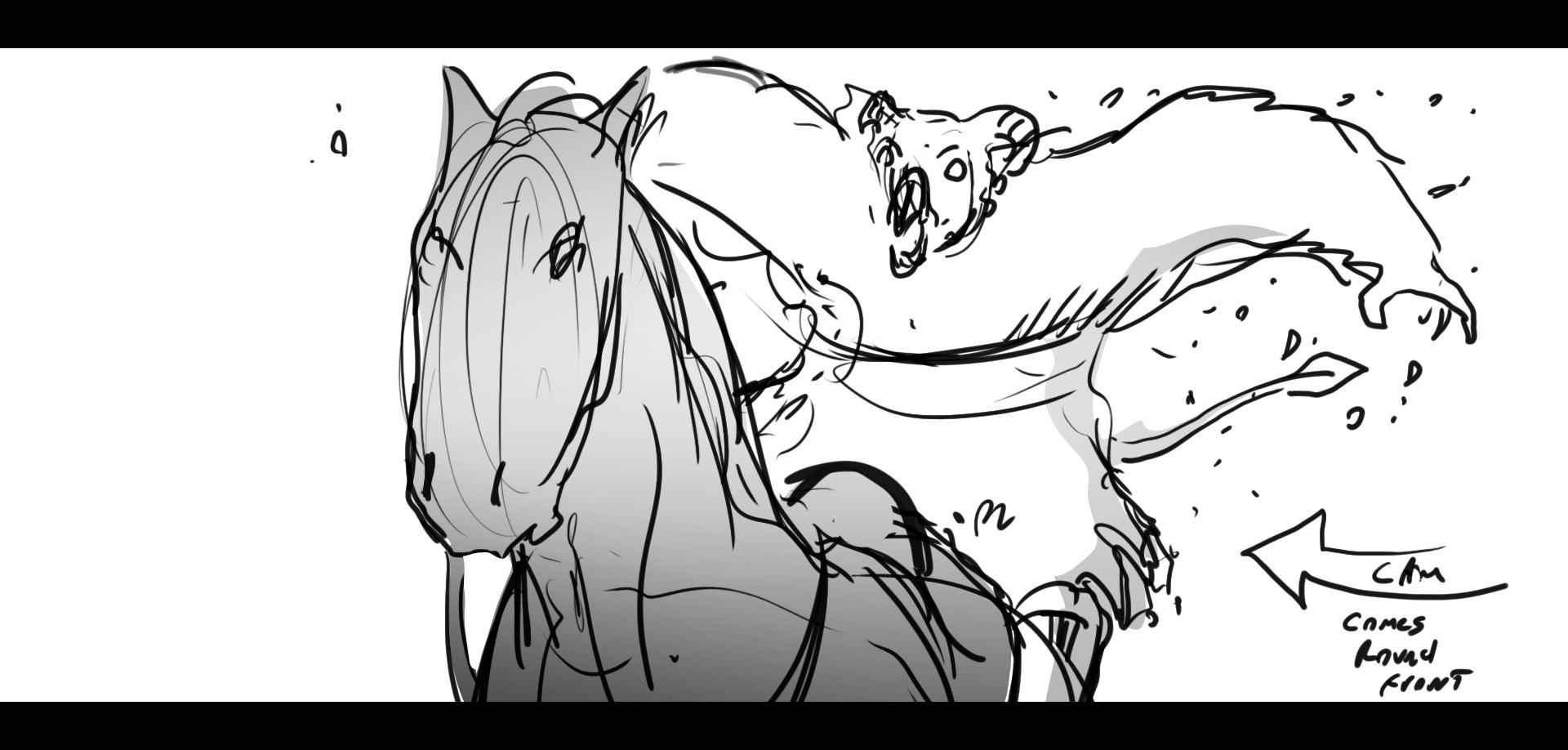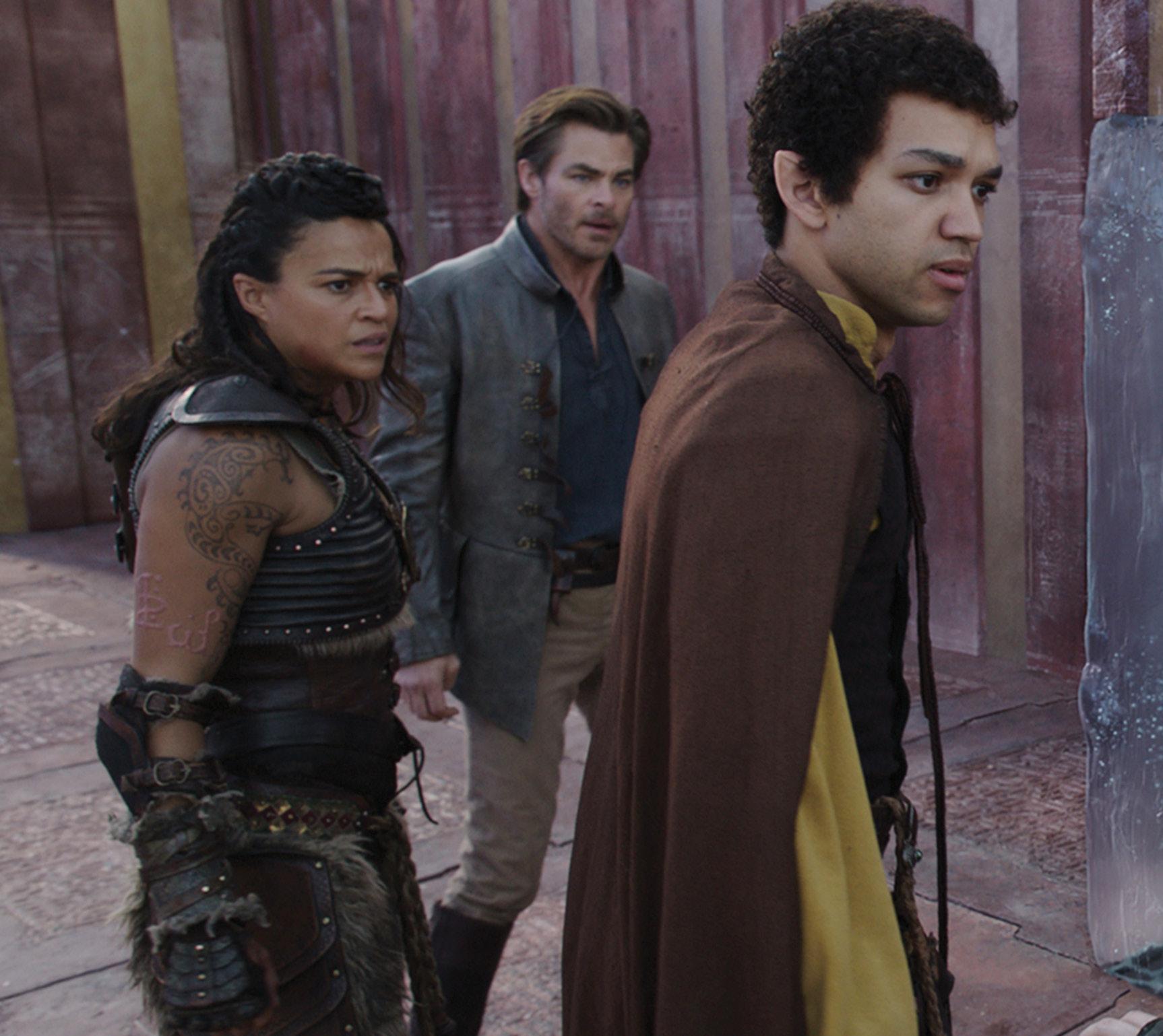
7 minute read
MONSTER MANUAL
Dungeons & Dragons: Honor Among Thieves has no shortage of monsters, beasts, and magical creatures that need to be brought to life.
BY BERNARD BOO
BRINGING THE WORLD OF DUNGEONS & DRAGONS from the tabletop to the big screen was no simple task, with hundreds of artists, animators, sculptors, and designers from different studios working in concert to make the film’s beasts, creatures, and curiosities look as ferocious and fantastical as they deserve to.
Den of Geek spoke with Shane Mahan and Lindsay MacGowan, co-owners of special effects studio Legacy Effects, and Todd Vaziri, compositing supervisor at ILM, who gave insight into the practical and digital effects that make Dungeons & Dragons: Honor Among Thieves’ monsters and magic look so distinctly D&D.
‡ THE OWLBEAR
Tiefling druid Doric, played by Sophia Lillis, has the enviable ability to shapeshift into a snowy owlbear, a hulking monstrosity with razor-sharp talons and a head that turns on a swivel. The team at ILM obviously had no real-life reference to help them, but the animators concentrated on giving the beast personality and conveying that there’s a humanoid brain in control of all the chaos.
“Even though we were doing this creature that is twice the size of a horse picking soldiers up and flinging them around, we had to keep an eye on the lightness and the comedy of the situation, which was a super fun challenge for us,” Vaziri explains.
One moment in the film that strikes the balance of brutality and humor involves Doric’s owlbear mauling a group of soldiers. “She’s on all fours, and she does a very owl-like look at her next target,” Vaziri explains. “Almost nothing in her body moves except for her head. It’s this little roundabout turn, and it’s really funny. Right after that look, the owlbear goes in to attack.”
As a digital creation, the owlbear looks incredibly tactile and plausible, with movements that mimic real-life animals. But Vaziri and the team at ILM were mindful of keeping things fun and supporting the lighter tone the filmmakers were going for.
“The typical movie that we work on is treated with extreme seriousness and gravitas,” Vaziri says. “The wonderful thing about this movie is that it has a twinkle in its eye. It’s funny, and the way we executed our visual effects had to support that. We don’t want to lose the charisma that the movie is trying to portray.”
‡ THE MIMIC
The original D&D jump-scare, mimics, have been a common peril in the game since the original Monster Manual, more often than not assuming the form of a tantalizing treasure chest to lure less perceptive adventurers into their fangy maws. Naturally, they make an appearance in the movie, with Michelle Rodriguez’s barbarian, Holga, falling victim to the monster’s ruse.
While the mimic that we see in the film was mostly rendered digitally by the ILM team, the folks at Legacy Effects lent their expertise with special effects and props to make the scene feel more visceral than it would have been otherwise.
“The action that takes place in that scene is so quick and so frenetic that we ended up just making the physical tongue that shoots out of the box,” Mahan explains. So the tongue that attacks Michelle is there physically, and then there’s a digital mimic treasure chest with teeth that are attached to the tongue.”
Legacy Effects and ILM have worked together on numerous films for decades, honing the art of marrying CGI and practical effects in a way that’s imperceptible to audiences. “We have a great relationship with the team at ILM,” Mahan says. “We’ve worked with them since way back when on Jurassic Park, so there’s a great camaraderie and collaboration that always happens with our teams.”
Because the filmmakers were so insistent on showing animatronics in-camera whenever possible, many of the creatures, like the mimic, were done as hybrid creations between the teams, which required a high level of coordination and planning. When Legacy builds the physical models and costumes, they take into consideration what enhancements they’ll need ILM to add later, from something as small as a flit of an eye to something as significant as a missing limb.
“If you have to have a blue screen sleeve on an arm that makes it look like it’s going to be gone, ILM has to do that,” Mahan explains. “Or maybe we hollow out a character’s nose, so we paint the actor’s nose black, and ILM adds the final touches. We’re big believers in collaboration.”
One of the most gratifying things for both effects houses to see is when audiences can’t discern whether or not a creature is made practically or digitally, which ultimately allows the viewer to not think about the effects at all and get lost in the story. “If we do our job well, nobody will be thinking about where one team’s work begins and the other’s ends.”

‡ THE GELATINOUS CUBE
The gelatinous cube, one of the most classic, hilarious enemies from D&D lore, makes an appearance in the film to wreak jiggly-wiggly havoc on the battlefield. Despite its seemingly simple makeup as a mindless mass that generally doesn’t move, the cubic creation posed a unique challenge for the team at ILM.

“Nobody’s ever seen anything quite like this before on film,” Vaziri explains. “We asked ourselves, well, what would it look like if humans were suspended inside a 15-foot by 15-foot cube made of gelatin? How would the gelatin react? How would the light refract through it? What happens to the heroes’ hair? How much could they move?”
The artists and engineers did extensive studying and experimenting, running simulations, and testing physics and lighting to get the look of the cube just right. They arrived at a point in their rendering where the cube looked incredibly realistic and accurate to how gelatin looks and behaves… but there was still something off about it.
“We were like, okay, it looks real,” Vaziri recalls. “But it’s not going to work for our movie.”
In the scene in question, the heroes dive into a gelatinous cube to avoid a pouncing, cat-like displacer beast. The actors are frozen in place with their faces stuck in hilarious expressions. But with the real-worldaccurate cube properties and physics in place, the camera wouldn’t be able to register the actor’s faces at all.
“We wanted to make sure those facial expressions came through,” Vaziri says. “So if the camera was outside the gelatinous cube, if the camera was inside the gelatinous cube, how do we make sure those expressions still read? That was an interesting challenge. We were tweaking and making up our own logic—like, wait a second, the camera can go through the cube, but the characters can’t move. We made it work. These were really fun problems to solve.”
‡ THE RED DRAGON
If you’ve seen the trailers for the film, you probably noticed a certain red, rotund dragon lumbering after the heroes on a mound of skeletons. While the filmmakers haven’t confirmed whether or not the red dragon is a specific dragon from D&D lore, the big guy looks to be a centerpiece in the movie’s menagerie of screen creations.
“There’s a scary-comedic feel to what the red dragon is,” Mahan says. “He’s too heavy to walk on those legs, so he kind of slides on his stomach, and his wings aren’t quite big enough to make him fly.”
While the red dragon is largely a digital creation because of its size and movement, Legacy did assist ILM in making the creature look as embedded in the environment as the rest of the more practically constructed monsters. “We made a skin section of the red dragon for lighting reference to use on set so that they had something physically there to match to,” MacGowan explains. Mahan adds that the section of reference dragon skin “was four feet by four feet with a translucent resin painted to the scales. Each one was the size of a dinner plate.”
The fear with CG characters like the red dragon is that they look detached from the environment in a way that’s distracting to the viewer. But Vaziri believes that embedding digital characters in the movie’s world goes beyond issues of fidelity and lighting. For him and his team, it’s more about matching the look of the movie on a deeper cinematic level.
“Yes, the aspects of reflection, refraction, diffuse, textures, paint, detail, movement… all of those things are incredibly valuable,” he explains. “But the visual effects need to fit the style of the movie. If you're watching a shot, a reverse shot of a bunch of actors talking, and then a creature comes out, and then all of a sudden, they’re using different lenses, everything’s in silhouette when nothing before this was in silhouette. The cuts are really short… it seems like they’re trying to hide something. For this movie, our visual effects had to match the camerawork for it to look and feel real.”
‡ THE CORPSES
One of the standout comedic scenes in the movie involves the heroes meeting reanimated corpses who explain how they died. The heroes are allowed five questions before the corpses die again (forever this time), and to the party’s dismay, Edgin the bard (Chris Pine) exhibits a tendency to ask dumb ones (“Four more questions, right?”). Legacy Effects handled the creation of the corpses, a job the studio was more than happy to tackle.

“When we first read the scene, conceptually, it was just so much fun,” Mahan says. “We don’t often get to do scenes that are comedic.”
The team wanted to match the lighter tone of the material, so they avoided the standard gruesome details you’d typically see with undead characters and zombies, instead opting for more stylized, expressive designs. “Our approach was to make them very interesting characters, but not entirely frightening or realistic because they’re seen as comedic.” MacGowan added that the producers and directors were “keen on it being sort of like the feeling of the Haunted Mansion from Disney; they’re fun to look at. They have a great deal of personality to them.”
Each corpse suffered a different death and has a unique story to tell, so their costuming and makeup had

